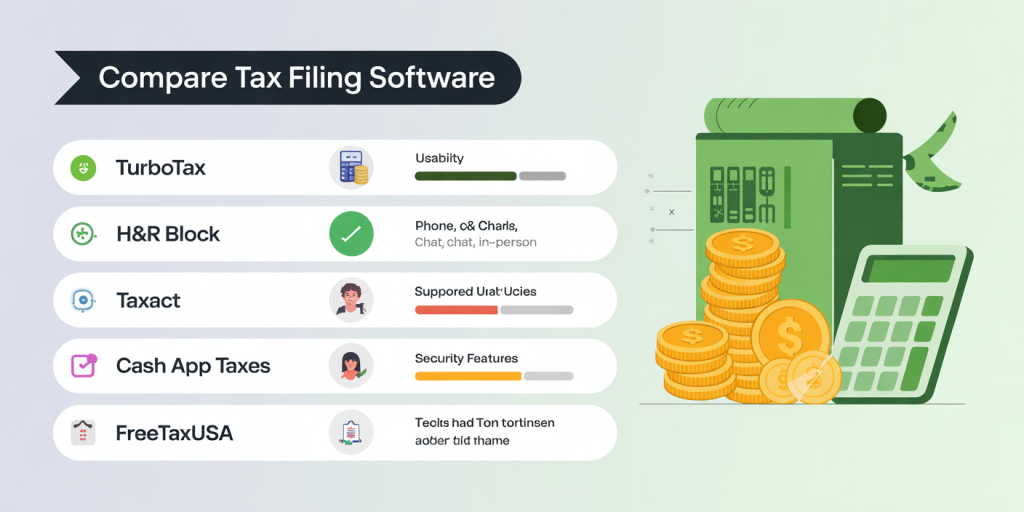Comparison: Top 5 Tax Filing Software Options in the U.S.
Filing taxes is a perennial task for millions of Americans every year, and the choice of tax filing software can make a significant difference in cost, efficiency, and accuracy. With the ongoing evolution of digital tax solutions, the U.S. market is flooded with a variety of software options, each promising simplicity, thoroughness, and maximum refunds. Understanding the features, pricing, user experience, and support services of the leading tax software providers is crucial to selecting the best fit for individual or business needs.


This comprehensive article evaluates the top five tax filing software options in the United States, comparing their strengths and weaknesses. Through practical examples, real case scenarios, and data-backed insights, readers will be empowered to make informed decisions during tax season.
—
Key Criteria for Evaluating Tax Filing Software
Selecting tax software involves assessing numerous factors beyond just price. Accuracy in calculations, ease of use, the ability to handle varying tax situations, customer support quality, and access to audit protection are vital aspects. According to a 2023 survey by J.D. Power, user satisfaction hinges primarily on software usability and error resolution rates.
For example, a self-employed freelancer with multiple income streams and deductible expenses would require more sophisticated software compared to a wage-earner filing a standard 1040 form. Similarly, families with dependents, mortgage interest deductions, or investment income will benefit from features tailored to more complex returns.
Tax software also varies in its ability to integrate with third-party platforms like financial aggregators or investment accounts, which can streamline data entry and reduce errors. Security and data privacy are non-negotiable, especially given the rise in tax-related identity theft.
The forthcoming analysis highlights these core criteria while offering comparative insights and tables that demonstrate how each of the top five software options measures up.
—
TurboTax: The Market Leader’s Comprehensive Solution
TurboTax by Intuit stands out as the U.S. market leader with a commanding share estimated around 30% according to IRS data on e-filed returns in 2023. Its popularity is built on an intuitive interface, step-by-step guidance, and robust import capabilities that make the process accessible for beginners and veterans alike.
The software’s user experience relies heavily on a Q&A style system that tailors questions based on individual circumstances. For example, if a taxpayer indicates freelance income, TurboTax will prompt additional queries about expenses, potentially maximizing deductions.
TurboTax offers multiple tiers: Free Edition for simple returns (Form 1040) Deluxe for homeowners and those with deductions Premier for investors and rental property owners Self-Employed for freelancers, contractors, and small business owners
This tiered approach allows users to select according to complexity, but pricing can escalate sharply; the Self-Employed version often costs over $120, plus $50 for state filings.
Security features include multi-factor authentication and encryption, addressing privacy concerns. The software also offers live CPA or EA support via TurboTax Live, allowing users to get real-time advice – a feature missing in many competitors.
Practical Case: Sarah, a freelance graphic designer from California, used TurboTax Self-Employed last year. She appreciated how the software automatically pulled data from her PayPal and Uber accounts and provided guidance on quarterly estimated tax payments. Her tax refund maximized through auto-populated deductions for home office expenses.
—
H&R Block: Trusted Name with In-Person Support Option
H&R Block is a legacy tax preparation firm with a strong presence both online and through brick-and-mortar offices. Their software platform reflects this hybrid model, offering ease of online filing combined with the potential for face-to-face consultations.
The software’s interface is straightforward and is recommended for users who may eventually need in-person help or prefer a local expert. H&R Block offers a free version for basic filings and three paid tiers: Deluxe – For homeowners and deductions Premium – For investors and rental property owners Self-Employed – For freelancers and small business owners
One significant advantage is that users starting their return online can visit a physical office for complex issues or to finalize their filing. This seamless transition between digital and physical service is a selling point.
According to 2023 consumer feedback surveys, H&R Block’s audit support and extended guarantee policies are considered industry-leading. This gives users confidence in their filings even in case of IRS scrutiny.
Practical Case: Michael, a small business owner in Texas, started his tax return online using H&R Block Premium. Midway, he realized he needed guidance about deducting business vehicle expenses. He scheduled an appointment at a nearby office and received personalized help, then completed his filing online without additional fees.
—
TaxAct: Affordable and Reliable for Cost-Conscious Filers
TaxAct has built its reputation around affordability and straightforward tax returns. It is popular among taxpayers with moderate complexity who want a reliable product without the premium cost attached to TurboTax or H&R Block.
TaxAct offers similar tiers: Free for simple returns Deluxe for homeowners and deductions Premier for investors and rental income Self-Employed for freelancers and small business owners
Its pricing structure is transparent and competitively lower, with state returns typically costing $40-$50. Although it lacks some of the bells and whistles of the market leaders, TaxAct maintains excellent accuracy and audit support. According to a 2023 comparison by NerdWallet, TaxAct achieves a high rating for value and features relative to price.
TaxAct is designed with a simple interface and less verbose explanatory text, which some users find efficient but others may find less guiding. The software also allows importing prior year data from competitors, facilitating conversions.
Practical Case: Emily, a public school teacher in Ohio, used TaxAct Deluxe to claim mortgage interest and education credits. She appreciated the lower cost compared to TurboTax and felt confident due to built-in error checking that caught a missed deduction for charitable donations.
—
Credit Karma Tax (Now Cash App Taxes): Completely Free Filing
Credit Karma Tax, rebranded as Cash App Taxes after acquisition by Block Inc., shook the market by offering completely free federal and state tax filing without upselling. This is a notable disruption compared to other providers charging upwards of $50 for state returns.
The software covers most forms including itemized deductions, investments, and self-employment income. It lacks live expert support but provides extensive help resources and stepwise instructions.
While the free pricing is attractive, there are limitations related to state support in some jurisdictions and delays in customer service responses due to cost constraints. However, a 2023 update improved platform stability and increased the number of covered tax forms.
Practical Case: Jake, a college student with part-time work and a small investment portfolio, filed his taxes easily using Credit Karma Tax. The zero cost for both federal and state saved him $60 compared to other providers, without sacrificing accuracy. However, he noted longer wait times when using help chat.
—
FreeTaxUSA: Budget Solution for Basic to Moderate Returns
FreeTaxUSA targets budget-conscious filers by offering 100% free federal filing and low-cost state returns (around $14.99). It supports numerous forms necessary for self-employed, rental, and investment income.
The interface is less polished but functional, focusing more on form completion than interactive guidance. Despite a minimalist design, FreeTaxUSA includes free audit assistance and guarantees the IRS acceptance of returns.
Its simplicity appeals to price-sensitive individuals with moderate filing complexity who are comfortable with minimal hand-holding.
Practical Case: Linda, a retiree in Florida, filed her return using FreeTaxUSA to claim Social Security benefits and minimal investment income. She saved approximately $100 over prior year software expenses, found the interface adequately straightforward, and appreciated the inclusion of free audit support.
—
Comparative Overview of Features and Pricing
The following table summarizes key dimensions of the five tax filing software options:
| Feature / Software | TurboTax | H&R Block | TaxAct | Cash App Taxes | FreeTaxUSA |
|---|---|---|---|---|---|
| Federal Filing Cost | $0 – $120+ (varies by tier) | $0 – $100+ (varies by tier) | $0 – $65 subset | $0 | $0 |
| State Return Cost | $50+ per state | $45+ per state | $40-$50 | $0 | $14.99 |
| Support Type | Live chat, phone, CPA help | Phone, chat, in-person | Email support, phone | Online FAQ, chat | Email support |
| Audit Support | Included (paid tiers) | Included | Included | Limited | Included |
| Import Capabilities | Excellent (banks, prior years) | Good | Good | Moderate | Moderate |
| Best for | Complex returns, self-employed | Hybrid online/in-person users | Budget-conscious moderate complexity | Simple to moderate returns, zero cost | Basic to moderate, budget users |
| Mobile App | Yes | Yes | Yes | Yes | Yes |
—
What the Future Holds for Tax Software in the U.S.
The future of tax filing software in the U.S. is shaped by increasing automation, AI-driven assistance, and seamless financial data integration. Artificial intelligence, including natural language processing and personalized recommendations, will continue to reduce taxpayer errors and optimize deductions.

For example, next-generation software could proactively identify overlooked tax credits by analyzing user transaction data, such as purchases or medical expenses, in real time. Blockchain technology might also play a role in secure and transparent data verification with the IRS.
Additionally, increased regulatory focus on data privacy and cybersecurity will drive software providers to bolster protections against identity theft. We can expect more multi-layered identity verification methods and end-to-end encryption as standard.
The competition will likely spur more zero-cost or freemium models akin to Cash App Taxes, pressuring legacy firms to innovate without compromising service quality. Hybrid models like H&R Block’s in-person options may evolve to combine AI-powered chatbots with human advisors for complex cases.
Finally, as the gig economy expands, software supporting self-employed and contract worker filings will need to address more nuanced tax scenarios including multi-state filings and cryptocurrency management. Offering tailored advisory services and built-in audit protection will become critical differentiators.
—
By carefully analyzing individual tax situations, budget constraints, and support preferences, taxpayers can select from these top five software providers with confidence. Each option brings distinct advantages to diverse user groups, signifying a dynamic and evolving market striving to simplify one of the most important annual financial activities for Americans.
